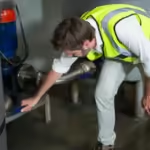Pneumatic seals in the USA are used in the below mentioned industries:
● Automotive
● Aerospace
● Gas
● Oil industries etc.
The seals ensure the productivity and reliability of pneumatic systems. This helps prevent compressed air or gas leakage.
Know about the seals more in this article below.
What is a pneumatic seal?
This specialized sealing device prevents the compressed air or gas from escaping. Industry professionals use these between moving parts in places like:
● Pneumatic cylinders
● Valves and
● Other equipment.
Manufacturers use different materials to make pneumatic seals such as:
● Rubber
● Polyurethane
● PTFE (polytetrafluoroethylene)
● Metal.
Types of pneumatic seals
Several types are designed for specific applications.
1. Piston seals
It creates a seal between the piston and cylinder bore of pneumatic cylinders. They prevent air or gas from bypassing the piston and ensure the cylinder operates efficiently.
2. Rod seals
These seals are placed on the rod or shaft of pneumatic cylinders and prevent the leakage of compressed air gas along the road. It protects the rod from dust and dirt but can cause damage to the cylinder.
3. Wiper seals
Industries use them to clean the rods of pneumatic cylinders that prevent dust from entering the cylinder. This is why professionals place them in front of the rod seal and help increase the lifespan of the seal and cylinder.
4. O Rings
Professionals like pneumatic and hydraulic specialists use these rings in pneumatic cylinders for their versatility and effectiveness.
They are circular, which is why manufacturers install them in channels to create a seal between two moving parts.
These rings come in various sizes and are made from different materials.
Applications of pneumatic seals
Industrial applications require careful consideration of various factors including the type, materials, size, etc.
● General mechanical devices
Pneumatic seals in the USA are found in air compressors and vacuum pumps.
Pneumatic drilling tools transform compressed air into a mechanical force to find concrete or for fine digging in dental enamel.
Vacuum pumps work by reducing pressure and causing materials to shift towards the vacuum.
You can also use inflatable rubber seals to squeeze and assist in the movement of the general mechanics.
● Automotive engineering
Automobile manufacturers use pneumatic seals in the air brakes of heavy vehicles. They use compressed air to press the brake pad against the disc and bring the vehicle to a halt.
The pressure applied by air brakes is higher than hydraulic brakes used in cars. This is because the compressed air forces back strong springs that try to apply the brake pads constantly.
The compressed air is released and the springs clamp into the brake pad with immense force when the driver steps on the brake pedal.
Inflatable rubber seals can also produce a mechanical holding force. You can use these seals to get the extra pressure.
● Foodstuff and packaging
Air is freely available and does not pollute food or packaging processes with fluid leaks out. Pneumatic seals are safer than hydraulic systems for food processing.
They are more suitable for the relatively lightweight lifting and moving requirements of food production and packaging.
Situations when you need to replace pneumatic seals
You should check regularly these seals for the following signs:
● Air leakage
It is the most obvious hint that your pneumatic seals need replacement. Leaks can be internal or external. It can occur in places like couplings, joints, etc.
You will also find them cropping up in hoses and tubes and in areas where the packing is worn. You can hear an air leak hissing but sometimes the sound might be masked by other noises. Your system pressure dropping is also another indicator of leaks.
● Contamination
It is crucial to clean the debris thoroughly from your system, including around the seals. This should be part of your preventive maintenance program. This is because any contamination like dust or dirt can damage seals and lead to failure.
● Wear and tear
Pneumatic seals in the USA are always prone to this. This occurs if the seals are exposed to harsh operating conditions. Chemicals and high temperatures affect them highly, which causes damage.
If you can spot any damage to your seals, you should always replace them.
● Temperature
Pneumatic seals in the USA can withstand -4 degrees Fahrenheit to + 176 degrees Fahrenheit.
These seals become fragile and crack and are susceptible to failure. It is crucial to ensure they can handle the working temperature range of your pneumatic cylinder. This is why you should be careful when you decide which material to use.
● Reduced performance
A drop in overall performance is another sign that your pneumatic seals need replacement.
For instance, your system might be taking longer to respond or demonstrating a loss of power.
● Age
Pneumatic seals in the USA have a short lifespan that depends on their quality. You should replace them every 2 to 3 years, or earlier if you perceive any of the signs mentioned previously.
Additionally, due to their frequent use in the sliding doors of trains, you should also regularly replace inflatable rubber seals.
Key Takeaways
As you are now aware of the types and applications of pneumatic seals in the USA, you should use them accordingly and replace them when you find any errors such as air leakage, contamination, temperature, reduced performance, lifespan, etc.
Ensure to get in touch with a reputed organization to replace the worn-out seals to ensure their longevity.
Visit our home-page for more information










